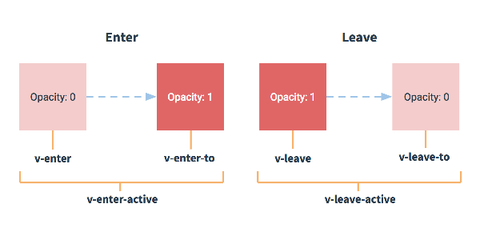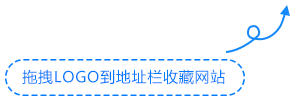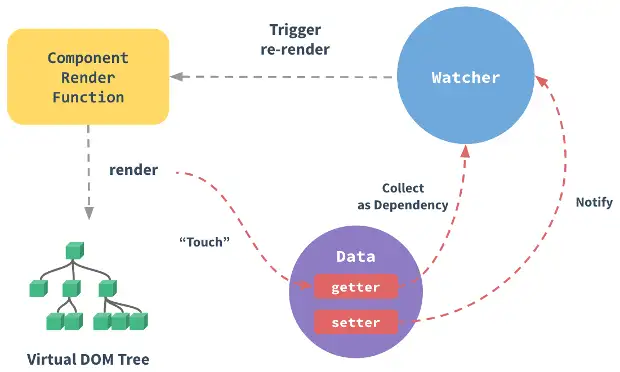Vue是一款高度封装的、开箱即用的、一栈式的前端框架,既可以结合webpack进行编译式前端开发,也适用基于gulp、grunt等自动化工具直接挂载至全局window使用。本文成文于Vue2.4.x版本发布之初,笔者生产环境当前使用的最新版本为2.5.2。在经历多个前端重度交互项目的开发实践之后,笔者结合官方文档对Vue技术栈进行了全面的梳理、归纳和注解,因此本文可以作为Vue2官方tutorial的补充性读物。
建议暂不具备Vue2开发经验的同学,完成官方tutorial的学习之后再行阅读本文。
Vue2.2.x之后的版本,Vue框架及其技术栈功能日趋完善,相比React+Reflux/Redux/MobX的一揽子组合,Vue在使用方式上更加贴近W3C技术规范(例如实现仍处于W3C草案阶段的<template>、<slot>、is等新特性,提供了良好易用的模板书写环境),并且技术栈和开源生态更加完整和易于配置,将React中大量需要手动编码处理的位置,整合成最佳实践并抽象为简单的语法糖(比如Vuex中提供的store的模块化特性),让开发人员始终将精力聚焦于业务逻辑本身。
Vue2的API结构相比Angular2更加简洁,可以自由的结合TypeScript或是ECMAScript6使用,并不特定于具体的预处理语言去获得最佳使用体验,框架本身的特性也并不强制依赖于各类炫酷的语法糖。Vue2总体是一款非常轻量的技术栈,设计实现上紧随W3C技术规范,着力于处理HTML模板组件化、事件和数据的作用域分离、多层级组件通信三个单页面前端开发当中的重点问题。本文在行文过程中,穿插描述了Angular、React等前端框架的异同与比较,供徘徊于各类前端技术选型的开发人员参考。
因为涉及到的知识点较多,因此本文相对其它技术类文章更长,最好结合markdown书签阅读,不过遗憾的是目前知乎暂时未能提供书签预览功能,且无法定义子级标题,所以需要使用原文书签的同学,请移步至本文的Github Pages,结合书签与多级标题能够更加直观的了解本文内容,也可以更加方便的定位并阅读特定章节。Vue 2 技术栈归纳与精粹
uinika.gitee.io/Web/Vue
欢迎大家关注公众号【IT圈】:Electronics, Embedded & Web
章:
Vue与Angular的比较
为了帮助知乎的小伙伴们更加快速的上手Vue2,特意将这篇文章分享出来,一方面为大家讲解Vue2带来的各种有趣特性,另一方面聊聊与之前使用Angular的相似与异同。
组件化
Angular的设计思想照搬了Java Web开发当中MVC分层的概念,通过Controller切割并控制页面作用域,然后通过Service来实现复用,是一种对页面进行纵向分层的解耦思想。而Vue允许开发人员将页面抽象为若干独立的组件,即将页面DOM结构进行横向切割,通过组件的拼装来完成功能的复用、作用域控制。每个组件只提供props作为单一接口,并采用Vuex进行state tree的管理,从而便捷的实现组件间状态的通信与同步。
Angular在1.6.x版本开始提供component()方法和Component Router来提供组件化开发的体验,但是依然需要依赖于controller和service的划分,实质上依然没有摆脱MVC纵向分层思想的桎梏。
双向绑定与响应式绑定
Vue遍历data对象上的所有属性,并通过原生Object.defineProperty()方法将这些属性转换为getter/setter(只支持IE9及以上浏览器)。Vue内部通过这些getter/setter追踪依赖,在属性被修改时触发相应变化,从而完成模型到视图的双向绑定。每个Vue组件实例化时,都会自动调用$watch()遍历自身的data属性,并将其记录为依赖项,当这些依赖项的setter被触发时会通知watcher重新计算新值,然后触发Vue组件的render()函数重新渲染组件。
与Aangular双向数据绑定不同,Vue组件不能检测到实例化后data属性的添加、删除,因为Vue组件在实例化时才会对属性执行getter/setter处理,所以data对象上的属性必须在实例化之前存在,Vue才能够正确的进行转换。因而,Vue提供的并非真正意义上的双向绑定,更准确的描述应该是单向绑定,响应式更新,而Angular即可以通过$scope影响view上的数据绑定,也可以通过视图层操作$scope上的对象属性,属于真正意义上的视图与模型的双向绑定。
var vm = new Vue({
data:{
a:1
}
})
vm.a = 1 // 响应的
vm.b = 2 // 非响应的
因此,Vue不允许在已经实例化的组件上添加新的动态根级响应属性(即直接挂载在data下的属性),但是可以使用Vue.set(object, key, value)方法添加响应式属性。
Vue.set(vm.someObject, “b”, 2)
// vm.$set()实例方法是Vue.set()全局方法的别名this.$set(this.someObject, “b”,2)
// 使用Object.assign()或_.extend()也可以添加响应式属性,但是需要创建同时包含原属性、新属性的对象,从而有效触发watch()方法this.someObject = Object.assign({}, this.someObject, { a: 1, b: 2 })
Vue对DOM的更新是异步的,观察到数据变化后Vue将开启一个队列,缓冲在同一事件循环(Vue的event loop被称为tick [tɪk] n.标记,记号)中发生的所有数据变化。如果同一个watcher被多次触发,只会向这个队列中推入一次。
Vue内部会通过原生JavaScript的Promise.then、MutationObserver、setTimeout(fn, 0)来执行异步队列当中的watcher。在需要人为操作DOM的场景下,为了在Vue响应数据变化之后再更新DOM,可以手动调用Vue.nextTick(callback),并将DOM操作逻辑放置在callback回调函数中,从而确保响应式更新完成之后再进行DOM操作。
<div id=“example”>{{message}}</div>
<script>
// 使用Vue实例上的.$nextTick()
var vue = new Vue({
el: “#example”,
data: {
message: “123”
}
})
vue.message = “new message” // 更改数据
vue.$el.textContent === “new message” // false
vue.nextTick(function () {
vm.$el.textContent === “new message” // true
})
</script>
<script>
// 组件内使用vm.$nextTick(),不需要通过全局Vue,且回调函数中this自动指向当前Vue实例Vue.component(“example”, {
template: “<span>{{ message }}</span>”,
data: function () {
return {
message: “没有更新”
}
},
methods: {
updateMessage: function () {
this.message = “更新完成”
console.log(this.$el.textContent) // 没有更新
this.$nextTick(function () {
console.log(this.$el.textContent) // 更新完成
})
}
}
})
</script>
Object.defineProperty()
Vue2的响应式绑定依靠JavaScript原生提供的Object.defineProperty()实现,下面通过手动完成了一个简单的响应式绑定,来展示其内在的工作机制。
<label>输入:</label>
<input id=”input” type=”text”><br/>
<label>输出:</label>
<input id=”output” type=”text” ></input>
<script>
const store = {};
const output = [];
Object.defineProperty(store, “element”, {
// 为store对象的element属性设置监听方法
set: value => {
output[“element”] = value;
},
get: () => {
return output[“element”];
}
});
let inputDOM = document.querySelector(“#input”);
let outputDOM = document.querySelector(“#output”);
inputDOM.onkeyup = () => {
store.element = inputDOM.value; // 为store对象设置element属性时候,会触该属性的set方法,此时inputDOM的value值将会赋予outputDOM。
outputDOM.value = output[“element”];
};
</script>
上面的示例中,通过操作DOM的方式完成数据绑定显然不够优雅,目前使用较为广泛的是Vue2所使用的Mustache胡须语法,因此如何更加语义化的完成数据绑定,成为下一步需要着手解决的问题:
<label>输入:</label>
<input id=”input” type=”text”>
<!– 使用了Handlebar的胡须表达式 –>
<p id=”output”>Handlebar编译后输出:{{element}}</p>
<script>
const store = {};
const output = [];
Object.defineProperty(store, “element”, {
// 为store对象的element属性设置监听方法
set: value => {
output[“element”] = value || “”;
},
get: () => {
return output[“element”];
}
});
let inputDOM = document.querySelector(“#input”);
let outputHTML = document.querySelector(“#output”).innerHTML;
compile(store, outputHTML); // 初始化编译
// 绑定输入框事件,并且实时编译DOM
inputDOM.onkeyup = () => {
store.element = inputDOM.value;
compile(store, outputHTML);
};
// 通过Handlebar编译使用了胡须语法的DOM
function compile(store, html) {
const template = Handlebars.compile(html);
document.querySelector(“#output”).innerHTML = template(store);
};
</script>
看起来工作得学不错,不过生产环境下需要完成的功能更多,比如对用户输入的内容进行清洗,以防止XSS;通过虚拟DOM和diff算法,更有效率的插入编译后的DOM等等,当然这些工作Vue2已经为你完成,开发人员只需要专注于业务代码本身。
虚拟DOM
Vritual DOM这个概念最先由React引入,是一种DOM对象差异化比较方案,即将DOM对象抽象成为Vritual DOM对象(即render()函数渲染的结果),然后通过差异算法对Vritual DOM进行对比并返回差异,最后通过一个补丁算法将返回的差异对象应用在真实DOM结点。
Vue当中的Virtual DOM对象被称为VNode(template当中的内容会被编译为render()函数,而render()函数接收一个createElement()函数,并最终返回一个VNode对象),补丁算法来自于另外一个开源项目snabbdom,即将真实的DOM操作映射成对虚拟DOM的操作,通过减少对真实DOM的操作次数来提升性能。
➜ vdom git:(dev)tree
├── create-component.js
├── create-element.js
├── create-functional-component.js
├── helpers
│ ├── extract-props.js
│ ├── get-first-component-child.js
│ ├── index.js
│ ├── is-async-placeholder.js
│ ├── merge-hook.js
│ ├── normalize-children.js
│ ├── resolve-async-component.js
│ └── update-listeners.js
├── modules
│ ├── directives.js
│ ├── index.js
│ └── ref.js
├── patch.js
└── vnode.js
VNode的设计出发点与Angular的$digest循环类似,都是通过减少对真实DOM的操作次数来提升性能,但是Vue的实现更加轻量化,摒弃了Angular为了实现双向绑定而提供的$apply()、$eval()封装函数,有选择性的实现Angular中$compile()、$watch()类似的功能。
Vue对象的选项
通过向构造函数new Vue()传入一个option对象去创建一个Vue实例。
var vm = new Vue({
// 数据
data: “声明需要响应式绑定的数据对象”,
props: “接收来自父组件的数据”,
propsData: “创建实例时手动传递props,方便测试props”,
computed: “计算属性”,
methods: “定义可以通过vm对象访问的方法”,
watch: “Vue实例化时会调用$watch()方法遍历watch对象的每个属性”,
// DOM
el: “将页面上已存在的DOM元素作为Vue实例的挂载目标”,
template: “可以替换挂载元素的字符串模板”,
render: “渲染函数,字符串模板的替代方案”,
renderError: “仅用于开发环境,在render()出现错误时,提供另外的渲染输出”,
// 生命周期钩子
beforeCreate: “发生在Vue实例初始化之后,data observer和event/watcher事件被配置之前”,
created: “发生在Vue实例初始化以及data observer和event/watcher事件被配置之后”,
beforeMount: “挂载开始之前被调用,此时render()首次被调用”,
mounted: “el被新建的vm.$el替换,并挂载到实例上之后调用”,
beforeUpdate: “数据更新时调用,发生在虚拟DOM重新渲染和打补丁之前”,
updated: “数据更改导致虚拟DOM重新渲染和打补丁之后被调用”,
activated: “keep-alive组件激活时调用”,
deactivated: “keep-alive组件停用时调用”,
beforeDestroy: “实例销毁之前调用,Vue实例依然可用”,
destroyed: “Vue实例销毁后调用,事件监听和子实例全部被移除,释放系统资源”,
// 资源
directives: “包含Vue实例可用指令的哈希表”,
filters: “包含Vue实例可用过滤器的哈希表”,
components: “包含Vue实例可用组件的哈希表”,
// 组合
parent: “指定当前实例的父实例,子实例用this.$parent访问父实例,父实例通过$children数组访问子实例”,
mixins: “将属性混入Vue实例对象,并在Vue自身实例对象的属性被调用之前得到执行”,
extends: “用于声明继承另一个组件,从而无需使用Vue.extend,便于扩展单文件组件”,
provide&inject: “2个属性需要一起使用,用来向所有子组件注入依赖,类似于React的Context”,
// 其它
name: “允许组件递归调用自身,便于调试时显示更加友好的警告信息”,
delimiters: “改变模板字符串的风格,默认为{{}}”,
functional: “让组件无状态(没有data)和无实例(没有this上下文)”,
model: “允许自定义组件使用v-model时定制prop和event”,
inheritAttrs: “默认情况下,父作用域的非props属性绑定会应用在子组件的根元素上。当编写嵌套有其它组件或元素的组件时,可以将该属性设置为false关闭这些默认行为”,
comments: “设为true时会保留并且渲染模板中的HTML注释”
});
Vue实例通常使用vm(View Model)变量来命名。
属性计算computed
在HTML模板表达式中放置太多业务逻辑,会让模板过重且难以维护。因此,可以考虑将模板中比较复杂的表达式拆分到computed属性当中进行计算。
<!– 不使用计算属性 –>
<div id=“example”>{{ message.split(“”).reverse().join(“”) }}</div>
<!– 将表达式抽象到计算属性 –>
<div id=“example”>
<p>Original message: “{{ message }}”</p>
<p>Computed reversed message: “{{ reversedMessage }}”</p>
</div>
<script>
var vm = new Vue({
el: “#example”,
data: {
message: “Hello”
},
computed: {
reversedMessage: function () {
return this.message.split(“”).reverse().join(“”)
}
}
})
</script>
计算属性只在相关依赖发生改变时才会重新求值,这意味只要上面例子中的message没有发生改变,多次访问reversedMessage计算属性总会返回之前的计算结果,而不必再次执行函数,这是computed和method的一个重要区别。计算属性默认只拥有getter方法,但是可以自定义一个setter方法。
<script>
… … …
computed: {
fullName: {
// getter
get: function () {
return this.firstName + ” “ + this.lastName
},
// setter
set: function (newValue) {
var names = newValue.split(” “)
this.firstName = names[0]
this.lastName = names[names.length – 1]
}
}
}
… … …
// 下面语句触发setter方法,firstName和lastName也会被相应更新
vm.fullName = “John Doe”
</script>
观察者属性watch
通过watch属性可以手动观察Vue实例上的数据变动,当然也可以调用实例上的vm.$watch达到相同的目的。
<div id=“watch-example”>
<p>Ask a yes/no question:<input v-model=“question”></p>
<p>{{ answer }}</p>
</div>
<script>
var watchExampleVM = new Vue({
el: “#watch-example”,
data: {
question: “”,
answer: “I cannot give you an answer until you ask a question!”
},
watch: {
// 如果question发生改变,该函数就会运行
question: function (newQuestion) {
this.answer = “Waiting for you to stop typing…”
this.getAnswer()
}
},
methods: {
// _.debounce是lodash当中限制操作频率的函数
getAnswer: _.debounce(
function () {
if (this.question.indexOf(“?”) === –1) {
this.answer = “Questions usually contain a question mark. ;-)”
return
}
this.answer = “Thinking…”
var vm = this
axios.get(“https://yesno.wtf/api”)
.then(function (response) {
vm.answer = _.capitalize(response.data.answer)
})
.catch(function (error) {
vm.answer = “Error! Could not reach the API. “ + error
})
},
// 这是用户停止输入等待的毫秒数
500
)
}
})
</script>
使用watch属性的灵活性在于,当监测到数据变化的时候,可以做一些设置中间状态之类的过渡处理。混合属性mixins
用来将指定的mixin对象复用到Vue组件当中。
// mixin对象
var mixin = {
created: function () {
console.log(“混合对象的钩子被调用”)
},
methods: {
foo: function () {
console.log(“foo”)
},
conflicting: function () {
console.log(“from mixin”)
}
}
}
// vue属性
var vm = new Vue({
mixins: [mixin],
created: function () {
console.log(“组件钩子被调用”)
},
methods: {
bar: function () {
console.log(“bar”)
},
conflicting: function () {
console.log(“from self”)
}
}
})
// => “混合对象的钩子被调用”
// => “组件钩子被调用”
vm.foo() // => “foo”
vm.bar() // => “bar”
vm.conflicting() // => “from self”
同名组件option对象的属性会被合并为数组依次进行调用,其中mixin对象里的属性会被首先调用。如果组件option对象的属性值是一个对象,则mixin中的属性会被忽略掉。渲染函数render()
用来创建VNode,该函数接收createElement()方法作为第1个参数,该方法调用后会返回一个虚拟DOM(即VNode)。
直接使用表达式,或者在render()函数内通过createElement()进行手动渲染,Vue都会自动保持blogTitle属性的响应式更新。
<h1>{{ blogTitle }}</h1>
<script>
render: function (createElement) {
return createElement(“h1”, this.blogTitle)
}
</script>
如果组件是一个函数组件,render()还会接收一个context参数,以便为没有实例的函数组件提供上下文信息。通过render()函数实现虚拟DOM比较麻烦,因此可以使用Babel插件babel-plugin-transform-vue-jsx在render()函数中应用JSX语法。
import AnchoredHeading from “./AnchoredHeading.vue”
new Vue({
el: “#demo”,
render (h) {
return (
<AnchoredHeading level={1}>
<span>Hello</span> world!
</AnchoredHeading>
)
}
})
Vue对象全局API
Vue.extend(options) // 通过继承一个option对象来创建一个Vue实例。
Vue.nextTick([callback, context]) // 在下次DOM更新循环结束之后执行延迟回调。
Vue.set(target, key, value) // 设置对象的属性,如果是响应式对象,将会触发视图更新。
Vue.delete(target, key) // 删除对象的属性,如果是响应式对象,将会触发视图更新。
Vue.directive(id, [definition]) Vue.filter(id, [definition]) Vue.component(id, [definition]) Vue.use(plugin) // 安装Vue插件。
Vue.mixin(mixin) // 全局注册一个mixin对象。
Vue.compile(template) // 在render函数中编译模板字符串。
Vue.version // 提供当前使用Vue的版本号。
Vue.mixin(mixin)
使用全局mixins将会影响到所有之后创建的Vue实例。
// 为自定义选项myOption注入一个处理器。
Vue.mixin({
created: function () {
var myOption = this.$options.myOption
if (myOption) {
console.log(myOption)
}
}
})
new Vue({
myOption: “hello!”
})
// => “hello!”
Vue.directive(id, [definition])
Vue允许注册自定义指令,用于对底层DOM进行操作。
Vue.directive(“focus”, {
bind: function() {
// 指令第一次绑定到元素时调用,只会调用一次,可以用来执行一些初始化操作。
},
inserted: function (el) {
// 被绑定元素插入父节点时调用。
},
update: function() {
// 所在组件的VNode更新时调用,但是可能发生在其子VNode更新之前。 },
componentUpdated: function() {
// 所在组件VNode及其子VNode全部更新时调用。
},
unbind: function() {
// 指令与元素解绑时调用,只会被调用一次。
}
})
钩子之间共享数据可以通过HTMLElement的dataset属性来进行(即HTML标签上通过data-格式定义的属性)。上面的钩子函数拥有如下参数:
el: 指令绑定的HTML元素,可以用来直接操作DOM。vnode: Vue编译生成的虚拟节点。oldVnode: 之前的虚拟节点,仅在update、componentUpdated钩子中可用。binding: 一个对象,包含以下属性:name: 指令名称,不包括v-前缀。value: 指令的绑定值,例如v-my-directive=”1 + 1″中value的值是2。oldValue: 指令绑定的之前一个值,仅在update、componentUpdated钩子中可用。expression: 绑定值的字符串形式,例如v-my-directive=”1 + 1″当中expression的值为”1 + 1″。arg: 传给指令的参数,例如v-my-directive:foo中arg的值是”foo”。modifiers: 包含修饰符的对象,例如v-my-directive.foo.bar的modifiers的值是{foo: true, bar: true}。上面参数除el之外,其它参数都应该是只读的,尽量不要对其进行修改操作。Vue.filter(id, [definition])
Vue可以通过定义过滤器,进行一些常见的文本格式化,可以用于mustache插值和v-bind表达式当中,使用时通过管道符|添加在表达式尾部。
<!– in mustaches –>
{{ message | capitalize }}
<!– in v-bind –>
<div v-bind:id=”rawId | formatId”></div>
<!– capitalize filter –>
<script>
new Vue({
filters: {
capitalize: function (value) {
if (!value) return “”
value = value.toString()
return value.charAt(0).toUpperCase() + value.slice(1)
}
}
})
</script>
过滤器可以串联使用,也可以传入参数。
<span>{{ message | filterA | filterB }}</span>
<span>{{ message | filterA(“arg1”, arg2) }}</span>
Vue.use(plugin)
Vue通过插件来添加一些全局功能,Vue插件都会覆写其install()方法,该方法第1个参数是Vue构造器, 第2个参数是可选的option对象:
MyPlugin.install = function (Vue, options) {
// 1. 添加全局方法或属性
Vue.myGlobalMethod = function () {}
// 2. 添加全局资源
Vue.directive(“my-directive”, {
bind (el, binding, vnode, oldVnode) {}
})
// 3. 注入组件 Vue.mixin({
created: function () {}
})
// 4. 添加实例方法
Vue.prototype.$myMethod = function (methodOptions) {}
}
通过全局方法Vue.use()使用指定插件,使用的时候也可以传入一个option对象。
Vue.use(MyPlugin, {someOption: true})
vue-router等插件检测到Vue是全局对象时会自动调用Vue.use(),如果在CommonJS模块环境中,则需要显式调用Vue.use()。实例属性和方法
Vue实例暴露了一系列带有前缀$的实例属性与方法。
let vm = new Vue();
vm = {
// Vue实例属性的代理 $data: “被watch的data对象”,
$props: “当前组件收到的props”,
$el: “Vue实例使用的根DOM元素”,
$options: “当前Vue实例的初始化选项”,
$parent: “父组件Vue对象的实例”,
$root: “根组件Vue对象的实例”,
$children: “当前实例的直接子组件”,
$slots: “访问被slot分发的内容”,
$scopedSlots: “访问scoped slots”,
$refs: “包含所有拥有ref注册的子组件”,
$isServer: “判断Vue实例是否运行于服务器”,
$attrs: “包含父作用域中非props的属性绑定”,
$listeners: “包含了父作用域中的v-on事件监听器”,
// 数据
$watch: “观察Vue实例变化的表达式、计算属性函数”,
$set: “全局Vue.set的别名”,
$delete: “全局Vue.delete的别名”,
// 事件
$on: “监听当前实例上的自定义事件,事件可以由vm.$emit触发”,
$once: “监听一个自定义事件,触发一次之后就移除监听器”,
$off: “移除自定义事件监听器”,
$emit: “触发当前实例上的事件”,
// 生命周期
$mount: “手动地挂载一个没有挂载的Vue实例”,
$forceUpdate: “强制Vue实例重新渲染,仅影响实例本身和插入插槽内容的子组件”,
$nextTick: “将回调延迟到下次DOM更新循环之后执行”,
$destroy: “完全销毁一个实例”,
}
$refs属性
子组件指定ref属性之后,可以通过父组件的$refs实例属性对其进行访问 。
<div id=“parent”>
<user-profile ref=“profile”></user-profile>
</div>
<script>
var parent = new Vue({ el: “#parent” })
var child = parent.$refs.profile // 访问子组件
</script>
$refs会在组件渲染完毕后填充,是非响应式的,仅作为需要直接访问子组件的应急方案,因此要避免在模板或计算属性中使用$refs。生命周期
每个Vue实例在创建时,都需要经过一系列初始化过程(设置数据监听、编译模板、挂载实例到DOM、在数据变化时更新DOM),并在同时运行一些钩子函数,让开发人员能够在特定生命周期内执行自己的代码。
不要在Vue实例的属性和回调上使用箭头函数,比如created: () => console.log(this.a)或vm.$watch(“a”, newValue => this.myMethod())。因为箭头函数的this与父级上下文绑定,并不指向Vue实例本身,所以前面代码中的this.a或this.myMethod将会是undefined。
通过jQuery对DOM进行的操作可以放置在Mounted属性上进行,即当Vue组件已经完成在DOM上挂载的时候。数据绑定
Vue视图层通过Mustache[“mʌstæʃ]语法与Vue实例中的data属性进行响应式绑定,但是也可以通过内置指令v-once完成一个单向的绑定,再或者通过v-html指令将绑定的字符串输出为HTML,虽然这样很容易招受XSS攻击。
<span>Message: {{ result }}</span>
<span v-once>一次性绑定: {{ msg }}</span>
<div v-html=“rawHtml”></div>
Mustache不能用于HTML属性,此时需要借助于v-bind指令。
<div v-bind:id=“dynamicId”></div>
<button v-bind:disabled=“isButtonDisabled”>Button</button>
绑定HTML的class和style
直接操作class与style属性是前端开发当中的常见需求,Vue通过v-bind:class和v-bind:style指令有针对性的对这两种操作进行了增强。
v-bind:class
绑定HTML的class属性。
<!– Vue对象中的data –>
<script>
… …
data: {
isActive: true,
hasError: false,
classObject: {
active: true,
“text-danger”: false
}
}
… …
</script>
<!– 直接绑定class到一个对象 –>
<div v–bind:class=“classObject”></div>
<!– 直接绑定class到对象的属性 –>
<div class=“static” v–bind:class=“{ active: isActive, “text–danger“: hasError }”></div>
<!– 渲染结果 –>
<div class=“static active”></div>
可以传递一个数组给v-bind:class从而同时设置多个class属性。
<!– Vue对象中的data –>
<script>
… …
data: {
activeClass: “active”,
errorClass: “text-danger”
}
… …
</script>
<!– 绑定class到计算属性 –>
<div v-bind:class=“[activeClass, errorClass]”></div>
<!– 渲染结果 –>
<div class=“active text-danger”></div>
<!– 使用三目运算符,始终添加errorClass,只在isActive为true时添加activeClass –>
<div v-bind:class=“[isActive ? activeClass : ““, errorClass]”></div>
<!– 在数组中使用对象可以避免三目运算符的繁琐 –>
<div v-bind:class=“[{ active: isActive }, errorClass]”></div>
当在自定义组件上使用class属性时,这些属性将会被添加到该组件的根元素上面,这一特性同样适用于v-bind:class。
<!– 声明一个组件 –>
<script>
Vue.component(“my-component”, {
template: “<p class=”foo bar“>Hi</p>”,
data: {
isActive: true
},
})
</script>
<!– 添加2个class属性 –>
<my–component class=“baz boo”></my-component>
<!– 渲染结果 –>
<p class=“foo bar baz boo”>Hi</p>
<!– 使用v–bind:class –>
<my–component v–bind:class=“{ active: isActive }”></my-component>
<!– 渲染结果 –>
<p class=“foo bar active”>Hi</p>
v-bind:style
绑定HTML的style属性。
<script>
… …
data: {
styleObject: {
color: “red”,
fontSize: “13px”
},
styleHeight: {
height: 10rem;
}
styleWidth: {
width: 20rem;
}
}
… …
</script>
<div v–bind:style=“styleObject”></div>
<!– 使用数组可以将多个样式合并到一个HTML元素上面 –>
<div v–bind:style=“[styleHeight, styleWidth]”></div>
使用v-bind:style时Vue会自动添加prefix前缀,常见的prefix前缀如下:
-webkit- Chrome、Safari、新版Opera、所有iOS浏览器(包括iOS版Firefox),几乎所有WebKit内核浏览器。-moz- 针对Firefox浏览器。-o- 未使用WebKit内核的老版本Opera。-ms- 微软的IE以及Edge浏览器。使用JavaScript表达式
Vue对于所有数据绑定都提供了JavaScript表达式支持,但是每个绑定只能使用1个表达式。
<span>{{ number + 1 }}</span>
<button>{{ ok ? “YES” : “NO” }}</button>
<p>{{ message.split(“”).reverse().join(“”) }}</p>
<div v-bind:id=””list-” + id”></div>
<!– 这是语句,不是表达式 –>
{{ var a = 1 }}
<!– if流程控制属于多个表达式,因此不会生效,但可以使用三元表达式 –>
{{ if (ok) { return message } }}
v-model双向数据绑定
v-model指令实质上是v-on和v-bind的糖衣语法,该指令会接收一个value属性,存在新值时则触发一个input事件。
<!– 使用v-model的版本 –>
<input v-model=“something”>
<!– 使用v-on和v-bind的版本 –>
<input v-bind:value=“something”
v-on:input=“something = $event.target.value”>
<!– 也可以自定义输入域的响应式绑定 –>
<custom-input
v-bind:value=“something”
v-on:input=“something = arguments[0]”>
</custom-input>
单选框、复选框一类的输入域将value属性作为了其它用途,因此可以通过组件的model选项来避免冲突:内置指令
带有v-前缀,当表达式值发生变化时,会响应式的将影响作用于DOM。指令可以接收后面以:表示的参数(被指令内部的arg属性接收),或者以.开头的修饰符(指定该指令以特殊方式绑定)。
<p v-if=“seen”>Hello world!</p>
<!– 绑定事件 –>
<a v-bind:href=“url”></a>
<!– 绑定属性 –>
<a v-on:click=“doSomething”>
<!– .prevent修饰符会告诉v-on指令对于触发的事件调用event.preventDefault() –>
<form v-on:submit.prevent=“onSubmit”></form>
Vue为v-bind和v-on这两个常用的指令提供了简写形式:和@。
<!– v-bind –>
<a v-bind:href=“url”></a>
<a :href=“url”></a>
<!– v-on –>
<a v-on:click=“doSomething”></a>
<a @click=“doSomething”></a>
目前,Vue在2.4.2版本当中提供了如下的内置指令:
<html
v-text = “更新元素的textContent”
v-html = “更新元素的innerHTML”
v-show = “根据表达式的true/false,切换HTML元素的display属性”
v-for = “遍历内部的HTML元素”
v-pre = “跳过表达式渲染过程,可以显示原始的Mustache标签”
v-cloak = “保持在HTML元素上直到关联实例结束编译,可以隐藏未编译的Mustache”
v-once = “只渲染元素和组件一次”
></html>
<!– 根据表达式的true和false来决定是否渲染元素 –>
<div v-if=“type === “A“”>A</div>
<div v-else-if=“type === “B“”>B</div>
<div v-else-if=“type === “C“”>C</div>
<div v-else>Not A/B/C</div>
<!– 动态地绑定属性或prop到表达式 –>
<p v-bind:attrOrProp
.prop = “被用于绑定DOM属性”
.camel = “将kebab-case特性名转换为camelCase”
.sync = “语法糖,会扩展成一个更新父组件绑定值的v-on监听器”
></p>
<!– 绑定事件监听器 –>
<button
v-on:eventName
.stop = “调用event.stopPropagation()”
.prevent = “调用event.preventDefault()”
.capture = “添加事件监听器时使用capture模式”
.self = “当事件是从监听器绑定的元素本身触发时才触发回调”
.native = “监听组件根元素的原生事件”–
.once = “只触发一次回调”
.left = “点击鼠标左键触发”
.right = “点击鼠标右键触发”
.middle = “点击鼠标中键触发”
.passive = “以{passive: true}模式添加监听器”
.{keyCode | keyAlias} = “触发特定键触事件“
>
</button>
<!– 表单控件的响应式绑定 –>
<input
v-model
.lazy = “取代input监听change事件”
.number = “输入字符串转为数字”
.trim = “过滤输入的首尾空格” />
组件
// 注册组件,传入一个扩展过的构造器Vue.component(“my-component”, Vue.extend({ … }))
// 注册组件,传入一个option对象(会自动调用Vue.extend)
Vue.component(“my-component”, { … })
var MyComponent = Vue.component(“my-component”)
下面代码创建了一个Vue实例,并将自定义组件my-component挂载至HTML当中。
<script>
// 注册自定义组件
Vue.component(“my-component”, {
template: “<div>A custom component!</div>”
})
// 创建Vue根实例
new Vue({
el: “#example”
})
</script>
<!– 原始模板 –>
<div id=“example”>
<my-component></my-component>
</div>
<!– 渲染结果 –>
<div id=“example”>
<div>A custom component!</div>
</div>
is属性浏览器解析完HTML之后才会渲染Vue表达式,但是诸如<ul> <ol> <table> <select>限制了可以被包裹的HTML元素,而<option>只能出现在某些HTML元素内部,造成Vue表达式可能不会被正确的渲染。因此,Vue提供is作为属性别名来解决该问题。
<!– 不正确的方式 –>
<table>
<my-row>…</my-row>
</table>
<!– 使用is的正确方式 –>
<table>
<tr is=“my-row”></tr>
</table>
data必须是函数Vue.component()传入的data属性不能是对象,而必须是函数。这样做的目的是避免组件在相同模板的多个位置被复用时,仅仅返回对象会造成组件间的数据被相互污染,而通过函数每次都返回全新的data对象能完美的规避这个问题。
Vue.component(“simple-counter”, {
template: “<button v-on:click=”counter += 1“>{{ counter }}</button>”,
data: function () {
return {
a: “”,
b: “”
}
}
});
父子组件之间的通信父组件通过props向下传递数据给子组件,子组件通过events给父组件发送消息,即props down, events up。
props
虽然每个组件的作用域都是独立的,但是可以通过props属性向子组件传递数据,这是一种单向数据流的体现形式。
Vue.component(“child”, {
// 声明props
props: [“message”],
// 和data属性一样,prop也可以在vm通过this.message进行引用 template: “<span>{{ message }}</span>”
})
不要在子组件内部修改props,这样会导致后台报错。命名方式转换
因为HTML并不区分大小写,所以kebab-case(驼峰)风格命名的props,在组件中会以camelCased(短横线隔开)风格被接收。
<!– camelCase in JavaScript –>
<script>Vue.component(“child”, {
props: [“myMessage”],
template: “<span>{{ myMessage }}</span>”
})<script>
<!– kebab-case in HTML –>
<child my-message=“hello!”></child>
动态props
可以通过v-bind指令,响应式的绑定父组件数据到子组件的props。当父组件数据变化时,该变化也会传导至子组件。
<div>
<input v-model=“parentMsg”>
<br>
<child v-bind:my-message=“parentMsg”></child>
</div>
使用v-bind可以让其参数值能够以JavaScript表达式的方式被解析,否则所有传入的props都会被子组件认为是字符串类型。
<!– 传递的是字符串”1″ –>
<comp some-prop=“1”></comp>
<!– 传递实际的 number –>
<comp v-bind:some-prop=“1”></comp>
验证props
可以为组件的props指定验证规则,如果传入数据不符合要求,Vue会发出相应警告,这样可以有效提高组件的健壮性。
Vue.component(“example”, {
props: {
// 基础类型检测
propA: Number,
// 多种类型
propB: [String, Number],
// 必传且是字符串
propC: {
type: String,
required: true
},
// 数字,有默认值
propD: {
type: Number,
default: 100
},
// 数组或对象的默认值由1个工厂函数返回
propE: {
type: Object,
default: function () {
return { message: “hello” }
}
},
// 自定义验证函数
propF: {
validator: function (value) {
return value > 10
}
}
}
});
props会在组件实例创建之前进行校验。组件的非props属性
组件可以接收任意传入的属性,这些属性都会被添加到组件HTML模板的根元素上(无论有没有在props中定义)。
<!– 带有属性的自定义组件 –>
<bs-date-input
data-3d-date-picker=”true”
class=”date-picker-theme-dark”>
</bs-date-input>
<!– 渲染出来的组件,class属性被合并 –>
<input type=”date” data-3d-date-picker=”true” class=”form-control date-picker-theme-dark”>
父组件传递给子组件的属性可能会覆盖子组件本身的属性,因而会对子组件造成破坏和污染。事件
子组件可以通过Vue的自定义事件与父组件进行通信。
每个Vue实例都实现了如下API,但是并不能直接通过$on监听子组件冒泡的事件,而必须使用v-on指令。
$on(eventName) 监听事件$emit(eventName) 触发事件$on和$emit并不是addEventListener和dispatchEvent的别名。<div id=“counter-event-example”>
<p>{{ total }}</p>
<button-counter v-on:increment=“incrementTotal”></button-counter>
<button-counter v-on:increment=“incrementTotal”></button-counter>
</div>
<script>
Vue.component(“button-counter”, {
template: “<button v-on:click=”incrementCounter“>{{ counter }}</button>”,
data: function () {
return {
counter: 0
}
},
methods: {
// 子组件事件
incrementCounter: function () {
this.counter += 1
this.$emit(“increment”) //向父组件冒泡事件
}
},
})
new Vue({
el: “#counter-event-example”,
data: {
total: 0
},
methods: {
// 父组件事件
incrementTotal: function () {
this.total += 1
}
}
})
</script>
.native修饰符开发人员也可以在组件的根元素上监听原生事件,这个时候需要借助到.native修饰符。
<my-component v-on:click.native=“doTheThing”></my-component>
.sync修饰符Vue中的props本质是不能进行响应式绑定的,以防止破坏单向数据流,造成多个子组件对父组件状态形成污染。但是生产环境下,props响应式绑定的需求是切实存在的。因此,Vue将.sync修饰符封装为糖衣语法,父组件在子组件的props使用该修饰符后,父组件会为props自动绑定v-on事件,子组件则在监听到props变化时向父组件$emit更新事件,从而让父组件的props能够与子组件进行同步。
<!– 使用.sync修饰符 –>
<comp :foo.sync=“bar”></comp>
<!– 被自动扩展为如下形式,该组件的子组件会通过this.$emit(“update:foo”, newValue)显式触发更新事件 –>
<comp :foo=“bar” @update:foo=“val => bar = val”></comp>
平行组件通信非父子关系的组件进行通信时,可以使用一个空的Vue实例作为中央事件总线。
var bus = new Vue()
// 触发组件A中的事件
bus.$emit(“id-selected”, 1)
// 在组件B监听事件
bus.$on(“id-selected”, function (id) {
… … …
})
更好的方式是借助VueX或者Redux之类的flux状态管理库。slot
可以将父组件的内容混入到子组件的模板当中,此时可以在子组件中使用<slot>作为父组件内容的插槽。
父组件模板的内容在父组件作用域内编译,子组件模板的内容在子组件作用域内编译。匿名插槽
当子组件只有一个没有属性的<slot>时,父组件全部内容片段将插入到插槽所在的DOM位置,并替换插槽标签本身。
<!– 子组件my-component的模板 –>
<div>
<h2>Child</h2>
<slot>
父组件没有需要插入的内容时显示
</slot>
</div>
<!– 父组件模板中使用my-component –>
<div>
<h1>Parent</h1>
<child>
<p>Content 1</p>
<p>Content 2</p>
</child>
</div>
<!– 渲染结果 –>
<div>
<h1>Parent</h1>
<div>
<h2>Child</h2>
<p>Content 1</p>
<p>Content 2</p>
</div>
</div>
<slot>标签中的内容会在子组件作用域内编译,并在父组件没有需要插入的内容时才会显示。具名插槽
可以通过<slot>元素的name属性来配置如何分发内容。
<!– 子组件 –>
<div id=“app”>
<header>
<slot name=“header”></slot>
</header>
<main>
<slot></slot>
</main>
<footer>
<slot name=“footer”></slot>
</footer>
</div>
<!– 父组件 –>
<app>
<div slot=“header”>Header</div>
<p>Content 1</p>
<p>Content 2</p>
<div slot=“footer”>Footer</div>
</app>
<!– 渲染结果 –>
<div id=“app”>
<header>
<div>Header</div>
</header>
<main>
<p>Content 1</p>
<p>Content 2</p>
</main>
<footer>
<p>Footer</p>
</footer>
</div>
匿名slot会作为没有匹配内容的父组件片段的插槽。作用域插槽
子组件通过props传递数据给<slot>插槽,父组件使用带有scope属性的<template>来表示表示当前作用域插槽的模板,scope值对应的变量会接收子组件传递来的props对象。
<!– 子组件通过props传递数据给插槽 –>
<div class=“child”>
<slot text=“hello from child”></slot>
</div>
<!– 父组件使用带有scope属性的<template> –>
<div class=“parent”>
<child>
<template scope=“props”>
<span>hello from parent</span>
<span>{{ props.text }}</span>
</template>
</child>
</div>
<!– 渲染结果 –>
<div class=“parent”>
<div class=“child”>
<span>hello from parent</span>
<span>hello from child</span>
</div>
</div>
函数化组件
即无状态(没有data)无实例(没有this上下文)的组件,渲染开销较小,且不会出现在Vue devtools当中。
Vue.component(“my-component”, {
functional: true,
// 通过提供context参数为没有实例的函数组件提供上下文信息 render: function (createElement, context) {},
// Props可选
props: {}
})
动态组件
使用<component>元素并动态绑定其is属性,可以让多个组件使用相同的Vue对象挂载点,并实现动态切换。
<script>
var vm = new Vue({
el: “#example”,
data: {
currentView: “home”
},
components: {
home: { /* … */ },
posts: { /* … */ },
archive: { /* … */ }
}
})
</script>
<component v–bind:is=“currentView”>
<!– 组件在vm.currentview变化时改变! –>
</component>
如果需要将切换的组件保持在内存,保留其状态并且避免重新渲染,可以使用Vue内置的keep-alive指令。
<keep-alive>
<component :is=“currentView”>
<!– 非活动组件将被缓存! –>
</component>
</keep-alive>
组件异步加载
Vue允许将组件定义为工厂函数,从而异步的解析组件定义。Vue只会在组件渲染时才触发工厂函数,并将结果缓存起来用于后续渲染。定义组件的工厂函数将会接收resolve(接收到从服务器下载的Vue组件options时被调用)和reject(当远程Vue组件options加载失败时调用)回调函数作为参数。
Vue.component(“async-example”, function (resolve, reject) {
setTimeout(function () {
// 将组件定义传递到resolve回调函数当中
resolve({
template: “<div>I am async!</div>”
})
}, 1000)
})
可以结合Webpack提供的代码切割功能,将Vue组件的options对象提取到单独JavaScript文件,从而实现异步的按需加载。
// 使用webpack的require()来进行异步代码块切割
Vue.component(“async-webpack-example”, function (resolve) {
require([“./my-async-component”], resolve)
})
// 使用webpack的import()来进行异步代码块切割Vue.component(
“async-webpack-example”, () => import(“./my-async-component”)
)
从Vue 2.3.0版本开始,可以通过下面的方式来定义一个异步组件。
const AsyncWebpackExample = () => ({
component: import(“./MyComp.vue”), // 需要加载的组件 loading: LoadingComp, // loading时渲染的组件
error: ErrorComp, // 出错时渲染的组件
delay: 200, // 渲染loading组件前的等待时间(默认:200ms) timeout: 3000 // 最长等待时间,超出则渲染error组件(默认:Infinity)
})
在路由组件上使用这种写法,需要使用vue-router的2.4.0以上版本。组件的循环引用
循环引用,即两个组件互相引用对方,例如下面代码中tree-folder、tree-folder-contents两个组件同时成为了对方的父或子节点,如果使用Webpack模块化管理工具requiring/importing组件的时候,会报出Failed to mount component: template or render function not defined.错误。
<template>
<p>
<span>{{ folder.name }}</span>
<tree-folder-contents :children=“folder.children”/>
</p>
</template>
<template>
<ul>
<li v-for=“child in children”>
<tree-folder v-if=“child.children” :folder=“child”/>
<span v-else>{{ child.name }}</span>
</li>
</ul>
</template>
因为tree-folder、tree-folder-contents相互引用对方之后,无法确定组件加载的先后顺序陷入死循环,所以需要事先指明webpack组件加载的优先级。解决上面例子中Vue组件循环引用的问题,可以在tree-folder组件的beforeCreate()生命周期函数内注册引发问题的tree-folder-contents组件。
beforeCreate: function () {
this.$options.components.TreeFolderContents = require(“./tree-folder-contents.vue”).default
}
组件命名约定
JavaScript中命名组件组件时可以使用kebab-case、camelCase、PascalCase,但HTML模板中只能使用kebab-case格式。
<kebab–cased–component></kebab-cased-component>
<camel–cased–component></camel-cased-component>
<pascal–cased–component></pascal-cased-component>
<!– 也可以通过自关闭方式使用组件 –>
<kebab–cased–component />
<script>
components: {
“kebab-cased-component”: {},
“camelCasedComponent”: {},
“PascalCasedComponent”: {}
}
</script>
推荐JavaScript中通过PascalCase方式声明组件, HTML中则通过kebab-case方式使用组件。组件递归
当局部注册的Vue组件递归调用自身时,需要在创建组件时添加name选项,全局注册的组件则可以省略该属性,因为Vue会自动进行添加。
// 局部注册
new Vue({
el: “#my-component”,
name: “my-component”,
template: “<div><my-component></my-component></div>”
})
// 全局注册
Vue.component(“my-component”, {
// name: “my-component”, 可以省略name属性
template: “<div><my-component></my-component></div>”
})
组件递归出现死循环时,会提示max stack size exceeded错误,所以需要确保递归操作都拥有一个终止条件(比如使用v-if并返回false)。组件模板
可以在Vue组件上使用inline-template属性,组件会将内嵌的HTML内容作为组件本身的模板进行渲染,而非将其作为slot分发的内容。<my-component inline-template>
<div>
<p>These are compiled as the component”s own template.</p>
<p>Not parent”s transclusion content.</p>
</div>
</my-component>
也可以通过在<script>标签内使用type=”text/x-template”和id属性来定义一个内嵌模板。
<script type=“text/x-template” id=“hello-world-template”>
<p>Hello hello hello</p>
</script>
<script>
Vue.component(“hello-world”, {
template: “#hello-world-template”
})
</script>
Vuex状态管理
Vuex是专门为Vue应用程序提供的状态管理模式,每个Vuex应用的核心是store(仓库),即装载应用程序state(状态)的容器,每个应用通常只拥有一个store实例。
Vuex的state是响应式的,即store中的state发生变化时,相应组件也会进行更新,修改store当中state的唯一途径是提交mutations。
const store = new Vuex.Store({
state: {
count: 0
},
mutations: {
increment (state) {
state.count++
}
}
})
store.commit(“increment”) 状态对象console.log(store.state.count) // 通过store.commit()改变状态
State
,每当state发生改变的时候都会重新执行计算属性,并且更新关联的DOM。
const Counter = {
template: `<div>{{ count }}</div>`,
computed: {
count () {
return store.state.count
}
}
}
Vuex提供store选项,将state从根组件注入到每个子组件中,从而避免频繁import store。
// 父组件中注册store属性
const app = new Vue({
el: “#app”,
store: store,
components: { Counter },
template: `
<div class=”app”>
<counter></counter> </div>`
})
// 子组件,store会注入到子组件,子组件可通过this.$store进行访问
const Counter = {
template: `<div>{{ count }}</div>`,
computed: {
count () {
return this.$store.state.count
}
}
}
Vuex提供mapState()辅助函数,避免使用多个state的场景下,多次去声明计算属性。
// 在单独构建的版本中辅助函数为 Vuex.mapStateimport { mapState } from “vuex”
export default {
computed: mapState({
count: state => state.count,
// 传递字符串参数”count”等同于`state => state.count`
countAlias: “count”,
countPlusLocalState (state) {
return state.count + this.localCount
}
})
}
// 当计算属性名称与state子节点名称相同时,可以向mapState传递一个字符串数组
computed: mapState([
“count” // 映射this.count到store.state.count
])
mapState()函数返回一个包含有state相关计算属性的对象,这里可以通过ES6的对象展开运算符…将该对象与Vue组件本身的computed属性进行合并。
computed: {
localComputed () {},
…mapState({})
}
Vuex允许在store中定义getters(可视为store的计算属性),getters的返回值会根据其依赖被缓存,只有当依赖值发生了改变才会被重新计算。该方法接收state作为第1个参数,其它getters作为第2个参数。可以直接在store上调用get
const store = new Vuex.Store({
state: {
todos: [
{ id: 1, text: “…”, done: true },
{ id: 2, text: “…”, done: false }
]
},
getters: {
doneTodos: (state, getters) => {
return state.todos.filter(todo => todo.done)
}
}
})
doneTodos = [{ id: 1, text: “…”, done: true }]store.getters.doneTodos
这样就可以方便的根据store中现有的state派生出新的state,从而避免在多个组件中复用时造成代码冗余。
computed: {
doneTodosCount () {
return this.$store.getters.doneTodos // 现在可以方便的在Vue组件使用store中定义的doneTodos }
}
Vuex提供的mapGetters()辅助函数将store中的getters映射到局部计算属性。
import { mapGetters } from “vuex”
export default {
computed: {
// 使用对象展开运算符将getters混入computed计算属性
…mapGetters([
“doneTodosCount”,
doneCount: “doneTodosCount” // 映射store.getters.doneTodosCount到别名this.doneCount
])
}
}
Mutations
修改store中的state的唯一方法是提交mutation([mjuː”teɪʃ(ə)n] n.变化),mutations类似于自定义事件,拥有一个字符串事件类型和一个回调函数(接收state作为参数,是对state进行修改的位置)。
const store = new Vuex.Store({
state: {
count: 1
},
mutations: {
// 触发类型为increment的mutation时被调用
increment (state) {
state.count++ // 变更状态
}
}
})
// 触发mutation
store.commit(“increment”)
可以通过store的commit()方法触发指定的mutations,也可以通过store.commit()向mutation传递参数。
// commit()
store.commit({
type: “increment”,
amount: 10
})
// store
mutations: {
increment (state, payload) {
state.count += payload.amount
}
}
mutation事件类型建议使用常量,并且将这些常量放置在单独文件,便于管理和防止重复。
// mutation-types.jsexport const SOME_MUTATION = “SOME_MUTATION”
// store.js
import Vuex from “vuex”
import { SOME_MUTATION } from “./mutation-types”
const store = new Vuex.Store({
state: { … },
mutations: {
// 可以通过ES6的计算属性命名特性去使用常量作为函数名 [SOME_MUTATION] (state) {
// mutate state
}
}
})
mutation()必须是同步函数,因为devtool无法追踪回调函数中对state进行的异步修改。Vue组件可以使用this.$store.commit(“xxx”)提交mutation,或者使用mapMutations()将Vue组件中的methods映射为store.commit调用(需要在根节点注入store)。
import { mapMutations } from “vuex”
export default {
methods: {
…mapMutations([
“increment” // 映射this.increment()为this.$store.commit(“increment”) ]),
…mapMutations({
add: “increment” // 映射this.add()为this.$store.commit(“increment”) })
}
}
Actions
Action用来提交mutation,且Action中可以包含异步操作。Action函数接受一个与store实例具有相s。
const store = new Vuex.Store({
state: {
count: 0
},
mutations: {
increment (state) {
state.count++
}
},
actions: {
increment (context) {
context.commit(“increment”)
}
}
})
生产环境下,可以通过ES6的解构参数来简化代码。
actions: {
// 直接向action传递commit方法 increment ({ commit }) {
commit(“increment”)
}
}
Action通过store.dispatch()方法进行分发,mutation当中只能进行同步操作,而action内部可以进行异步的操作。下面是一个购物车的例子,代码中分发了多个mutations,并进行了异步API操作。
actions: {
checkout ({ commit, state }, products) {
const savedCartItems = […state.cart.added] // 把当前购物车的物品备份起来
commit(types.CHECKOUT_REQUEST) // 发出结账请求,然后清空购物车 // 购物Promise分别接收成功和失败的回调
shop.buyProducts(
products,
() => commit(types.CHECKOUT_SUCCESS), // 成功操作
() => commit(types.CHECKOUT_FAILURE, savedCartItems) // 失败操作
)
}
}
组件中可以使用this.$store.dispatch(“xxx”)分发action,或者使用mapActions()将组件的methods映射为store.dispatch(需要在根节点注入store)。
import { mapActions } from “vuex”
export default {
methods: {
…mapActions([
“increment” // 映射this.increment()为this.$store.dispatch(“increment”)
]),
…mapActions({
add: “increment” // 映射this.add()为this.$store.dispatch(“increment”)
})
}
}
store.dispatch可以处理action回调函数当中返回的Promise,并且store.dispatch本身仍然返回一个Promise。
actions: {
// 定义一个返回Promise对象的actionA
actionA ({ commit }) {
return new Promise((resolve, reject) => {
setTimeout(() => {
commit(“someMutation”) // 触发mutation
resolve()
}, 1000)
})
},
// 也可以在actionB中分发actionA
actionB ({ dispatch, commit }) {
return dispatch(“actionA”).then(() => {
commit(“someOtherMutation”) // 触发另外一个mutation
})
}
}
// 现在可以分发actionA
store.dispatch(“actionA”).then(() => {
… … …
})
可以体验通过ES7的异步处理特性async/await来组合action。
actions: {
async actionA ({ commit }) {
commit(“gotData”, await getData())
},
async actionB ({ dispatch, commit }) {
await dispatch(“actionA”) //等待actionA完成
commit(“gotOtherData”, await getOtherData())
}
}
Module
整个应用使用单一状态树的情况下,所有state都会集中到一个store对象,因此store可能变得非常臃肿。因此,Vuex允许将store切割成模块(module),每个模块拥有自己的state、mutation、action、getter、甚至是嵌套的子模块。
const moduleA = {
state: {},
mutations: {},
actions: {},
getters: {}
}
const moduleB = {
state: {},
mutations: {},
actions: {}
}
const store = new Vuex.Store({
modules: {
a: moduleA,
b: moduleB
}
})
store.state.a // moduleA的状态
store.state.b // moduleB的状态
module内部的mutations()和getters()接收的第1个参数是模块的局部状态对象。
const moduleA = {
state: { count: 0 },
mutations: {
increment (state) {
state.count++ // 这里的state是模块的局部状态 }
},
getters: {
doubleCount (state) {
return state.count * 2
}
}
}
const moduleA = {
// …
actions: {
incrementIfOddOnRootSum ({ state, commit, rootState }) {
if ((state.count + rootState.count) % 2 === 1) {
commit(“increment”)
}
}
}
}
模块内部的getters()方法,可以通过其第3个参数接收到全局状态。
const moduleA = {
getters: {
sumWithRootCount (state, getters, rootState) {
return state.count + rootState.count
}
}
}
严格模式
严格模式下,如果state变化不是由mutation()函数引起,将会抛出错误。只需要在创建store的时候传入strict: true即可开启严格模式。
const store = new Vuex.Store({
strict: true
})
不要在生产环境下启用严格模式,因为它会深度检测不合法的state变化,从而造成不必要的性能损失,我们可以通过在构建工具中增加如下判断避免这种情况。
const store = new Vuex.Store({
strict: process.env.NODE_ENV !== “production”
})
严格模式下,在属于Vuex的state上使用v-model指令会抛出错误,此时需要手动绑定value并监听input、change事件,并在事件回调中手动提交action。另外一种实现方式是直接重写计算属性的get和set方法。总结
应用层级的状态应该集中到单个store对象中。提交mutation是更改状态的唯一方法,并且这个过程是同步的。异步逻辑都应该封装到action里面。欢迎优秀原创技术类、IT产业经济类文章向知乎【成都IT圈】专栏进行投稿。欢迎大家关注公众号【IT圈】:Electronics, Embedded & Web

















